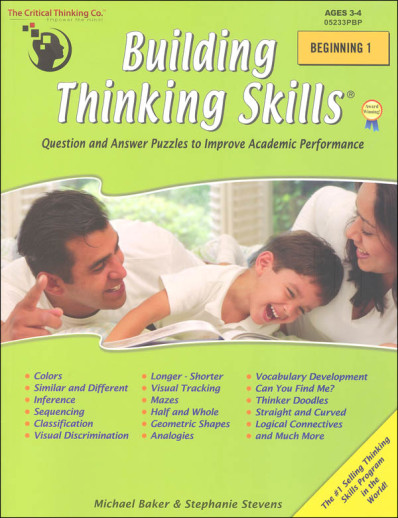We use cookies to make your experience better. To comply with the new e-Privacy directive, we need to ask for your consent to set the cookies. Learn more.
Building Thinking Skills Beginning 1
The starting point for the Building Thinking Skills series, the Beginning 1 course is intended for children ages 3 and 4. Pages are brightly colored and uncluttered, with engaging exercises for little ones. Basic skills covered include colors, similarities and differences, geometric shapes, inference, measurement, problem solving, and analogies. At a deeper level, two pages at the beginning show which exercises relate to physiological development and cognitive skills such as visual tracking, auditory processing, and fine motor skills development, among others. If you notice an area that needs extra attention, you can focus on exercises in that section. No manipulatives are required, but some of the exercises mention attribute blocks. It would be appealing to the student to use these, and if you go on to Building Thinking Skills Primary, you will need them anyway. 224 pgs.
This colorful, fun 224-page book develops critical thinking skills necessary for success in reading, writing, math, science, social studies, and standardized tests. It also teaches many academic concepts and skills taught in kindergarten and first grade.
The fun, highly-effective and engaging reasoning activities improve the vocabulary, pre-reading, pre-writing, math, logic, spatial, and auditory processing skills of preschoolers. It teaches students to use organized analysis instead of guesswork to solve problems. The book may be used as a complete critical thinking curriculum to prepare young minds for preschool academics.
Teaching Support
Activities are modeled to reinforce reasoning skills and concepts. Building Thinking Skills® Beginning may be used with attribute blocks (optional). See components sold separately above for ordering information for these manipulatives.
This is a very complete thinking skills program, covering all of the figural and verbal skills your children are likely to see on a standardized test. The publisher, Critical Thinking Press, states that Building Thinking Skills is "designed to significantly improve verbal and figural skills in four important areas: similarities and differences, sequences, classifications, and analogies. Proficiency in these skills is the cornerstone of success in all academic areas, on standardized tests, and on college entrance exams." They have scads of testimonials documenting the correlation between use of this series and increased test scores. We have no doubt that all the practice you get in using this series would, indeed, improve test scores. More importantly, many of the specific skills practiced here also have application in different professions. Other skills would seem to generally improve your ability to "see things" in different ways or train your mind to stretch in different directions.
The broader goals of this series are translated into specific skills and exercises within these areas. Learning is spiral within skills, within books, and between levels. That is, exercises progress in sophistication and scope within each book, and from level to level. This translates into several hefty worktexts full of practice exercises that children actually enjoy doing! Except for the Primary level, students can work pretty much on their own, proceeding as quickly through the series as they're able. If you're starting an older child in the series, however, use the suggested grade levels for proper placement.
| Product Format: | Paperback Book |
|---|---|
| Brand: | Critical Thinking Company |
| Grade: | PK |
| ISBN: | 9780894559112 |
| Length in Inches: | 11 |
| Width in Inches: | 8.5 |
| Height in Inches: | 0.5 |
| Weight in Pounds: | 1.55 |

